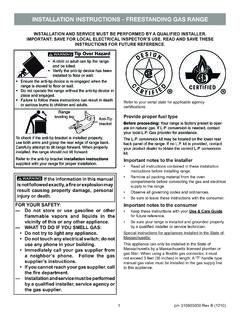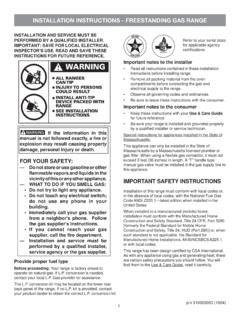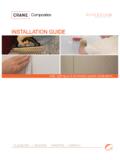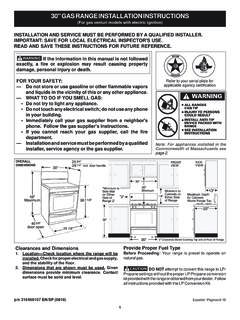Transcription of under cabinet range hood installation instructions
1 Page 1L109 0516 AULCUSRRead and Save These instructions All Hoods Must Be Installed By A Qualified InstallerINSTALLATION instructions under cabinet HOODRead All instructions Thoroughly Before Beginning InstallationWARNING - TO REDUCE THE RISK OF FIRE, ELECTRIC SHOCK, OR INJURY TO PERSONS, OBSERVE THE FOLLOWING:A. installation work and electrical wiring must be done by qualified person(s) in accordance with all applicable codes and standards, including fire-rated construction. Switch power off at service panel and lock the service disconnecting means to prevent power from being switched on accidentally during When cutting or drilling into wall or ceiling, do not damage electrical wiring and other hidden Ducted fans must always be vented to the Sufficient air is needed for proper combustion and exhausting of gases through the flue (chimney) of fuel burning equipment to prevent back drafting.
2 Follow the heating equipment manufacturer s guideline and safety standards such as those published by the National Fire Protection Association (NFPA), and the American Society for Heating, Refrigeration and Air Conditioning Engineers (ASHRAE), and local code ASHRAE residential ventilation standard limits exhaust fans (total) to a maximum of 15 CFM per 100 square feet of occupiable space, unless a back drafting test is performed or make-up air is provided. Consult a local HVAC engineer for make-up air - TO REDUCE THE RISK OF FIRE, USE ONLY METAL DUCTWORKPage 2L109 0516 ADucting Do s and Don tsYESNOS mooth DuctSmooth Gradual TurnProper Combiningof Two DuctsFlexible DuctSharp Angled TurnsImproper Combining of Two DuctsGeneral Requirements Observe local codes regarding special duct requirements and placement of duct against combustibles.
3 Using Vent-A- hood transitions (back page) will ensure proper efficiency. Using Vent-A- hood roof jacks or wall louvers (back page) will ensure proper efficiency. Where possible, seal joints with duct tape. The hood must be ducted to the outdoors without Requirements The single blower unit (B100) requires 6 round duct or equivalent (28 square inches), and the dual blower unit (B200) requires 8 round duct or equivalent (50 square inches).BlowerCombined Duct DizeSq. Inch AreaVent-A- hood TransitionSingle (B100)6" round or equivalent28 sq. (B200)8" round or equivalent50 sq. and Dual (B100 & B200)10" round or equivalent79 sq. (Optional)Two Duals (Two B200s)12" round or equivalent113 sq. (Optional)Ducting Requirements NEVER reduce the duct size.
4 When combining ducts together, the square inch area must reflect the total square inch area of the ducts being combined. Do not use flexible or corrugated duct. This type of duct will restrict airflow and reduce performance. Only use smooth, galvanized, metal duct. Make the duct run as short and as straight as possible with as few turns as possible. Avoid sharp-angled turns. Instead, use smooth, gradual turns such as adjustable elbows or 45 degree angled turns. For duct runs over 20 feet, increase the duct diameter by one inch for every ten feet of duct. A 90 degree elbow is equal to 5 feet of Requirements Airflow must not be restricted at the end of the duct run. A wall louver or roof jack is required for each duct run.
5 Every wall louver or roof jack must include a gravity damper to prevent back drafts. Do not use screen wire or spring-loaded doors on wall louvers or roof jacks. Do not terminate venting into an attic or 3L109 0516 AInstallation Details1) Read all instructions thoroughly before beginning installation . Note: These instructions apply to standard hoods only. Custom hoods may require additional specification ) When installing a 9 tall under cabinet hood , it is recommended that the bottom edge of the hood be located no more than 24 - 27 above the cooking surface for optimum ) Inspect the underside of the cabinet for a flush mounting surface. If the underside is recessed, install wood strips to provide a flush surface for the hood mounting screws to ) Cut hole(s) in the bottom of the cabinet to allow for duct(s) and electrical to pass through.
6 Consult the connection diagrams (on next page) for further details on exhaust outlet and electrical ) IF THE hood IS TO BE BACK VENTED , PROCEED DIRECTLY TO STEP 6. Install the duct(s) from the outside of the home down to the location of the exhaust outlet(s) on the top of the hood allowing room for the transition (if applicable). If a transition is used, install duct down to the location of the transition outlet plus 1 . This will allow the transition to engage 1 inside of duct. Consult the connection diagrams (on next page) for further details on exhaust outlet placement. Use duct tape to seal all joints. A complete listing of available Vent-A- hood ducting materials is provided on the back page of this instruction sheet.
7 Transition heights are as follows:Single Blower (B100): 6 round duct will connect directly to the top of the Blower (B200): 8 round duct will connect directly to the top of the and Dual Blower (B100 & B200): 6 round duct will connect directly to the top of the hood ; 8 round will connect directly to the top of the hood . Optional 10 round combination transition (VP562, sold separately) is 17 1/2 Dual Blowers (Two B200s): Two 8 rounds connect directly to the top of the hood . Optional 12 round combination transition (VP563, sold separately) is 16 1/2 4L109 0516A6 OutletVentHole3 ElectricalCenterlineof HoodWall Side1 1 5 Electrical1 Centerlineof Hood8 OutletVentHoles5 5 Wall Side8 Outlet6 Outlet5 Wall SideVentHolesCenterlineof HoodElectrical (2)5 7 1 7 1 11 11 5 5 Wall Side5 1 Electrical (2)8 OutletVentHoles8 OutletCenterlineof HoodInstallation Details ContinuedConnection Diagrams (30 - 48 Widths)Connection Diagram (42 - 48 Widths)Connection Diagram (48 Width)900 CFM B200 Dual & B100 Single Blower(Top View)1200 CFM Double B200 Dual Blowers(Top View)6)
8 Remove the hood from its packaging and place the back of the hood on the floor or countertop in front of the cabinet where it will ) Remove the shipping tape that is securing the E-Z Clean shield(s) inside the hood . Remove the E-Z Clean shield(s) by lightly pulling it toward the front of the hood . Gently close the back draft damper(s) from the top side of the hood . To remove the blower housing(s), unsnap the suitcase latches (one on each side of the housing). The housing(s) should be pulled forward and gently tipped to clear the blower wheel(s) and then out of the ) Remove the three screws retaining the blower motor(s). Unplug and remove the motor(s), taking care not to damage the blower wheel(s). It is not necessary to remove the blower wheel from the : Make sure power is off and locked at the service disconnecting means on the service panel during CFM B100 Single Blower(Top View)600 CFM B200 Dual Blower(Top View)Page 5L109 0516A16) Plug the motor(s) into the hood and reinstall the blower motor(s) using the three retaining screws that were previously removed in Step ) Replace the blower housing(s) and the blower shield(s).
9 Make sure that the damper(s) open and close ) Refer to the Owner Maintenance guide Operating instructions for proper hood operation. Test all blower and light functions to ensure they are operating ) Install an appropriate 1/2 UL listed electrical wire clamp through each motor box electrical opening on top of the hood . Install electrical wiring from the service panel to the hood location for each motor box. Consult the connection diagrams (on previous page) for further details on electrical Details Continued10) Insert the electrical wire from the service panel into the electrical wire clamp on each motor box. Tighten the wire clamp(s).11) FOR BACK VENTING APPLICATIONS ONLY. IF NOT BACK VENTING, SKIP STEP 12. PROCEED DIRECTLY TO STEP 13.
10 Note: Wall studs may interfere with back venting installations. Additional framing may be required. It is necessary to cut duct access hole(s) in the wall prior to installing the hood . To accomplish this, place the appropriate elbow(s) on the bottom of the cabinet in line with the duct hole(s) cut in Step 4. On the wall, trace around the elbow(s). Be sure to account for the wood thickness of the bottom of the cabinet when tracing duct access holes. Remove the elbow(s) from the cabinet . Cut around the outside of the traced line(s), avoiding wall studs. Install the duct from the outside of the home to the opening in the wall. Use duct tape to seal ) Pull the electrical wire slack into the cabinet while raising the hood into position.









